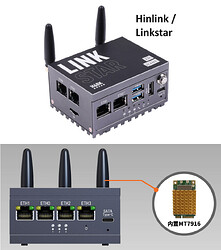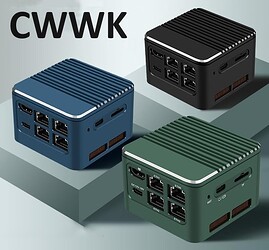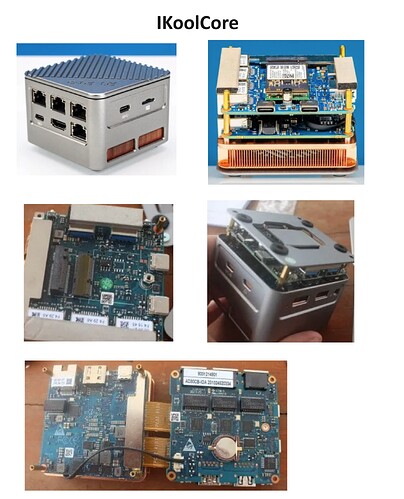I’m afraid it is because for most 14 antennas is pretty unwieldy and they do not look forward paying more for antennas than the board itself.
Simon said they’ll look into 10 antenna version after they fix thermal issues and openwrt one
ok, 14 antennas would technically be better.
but can someone please tell me or point me to a link which shows the difference in
speed, performance, stability,qos, amount of clients
between 6 and 14 antennas? because I actually think most people just want more antennas without any actual benefit.
this device is still hard a work in progress. the software is not yet finished at all. this is not an end-user-device yet. it is still hard in work. if there will be a 6/10/14-antenna version, no one knows, as long as there is no concrete statement from sinovoip. when they marketed it as 14-antenna-device, thats bad, if there wont be any. but tbh, i guess there might be something coming, but probably not in the beginning. when sinovoip sees the requests and that there is money to earn, they probably will do it. if not, then probably not. crying in the forum doesnt help. contact them, tell them your concerns and see what they answer. everything else is just wasted resources. and it annoys me to read stuff like “im not going to buy XYZ when ABC is not included”. I did such stuff too, when i was 12 or so. it wont help you nor anyone else.
Well, if we go back to MediaTek’s blog post from June 2023 when they “partnered” with Banana Pi to develop a 4T5R module with the Filogic 880 (the original 14-antenna version).
MediaTek’s unique 4T5R platform allows for improved Receive Diversity and supports MRC (Multiple Receive Combining). This boosts 6GHz band throughput in typical indoor scenarios and extends maximum range, assuring incredible performance as well as more reliable and effective mesh networking when 6GHz is used as backhaul.
This was supposed to be the unique selling point to buying a BPI-R4 was that we were supposed to have asynchronous antenna diversity on the receiving end to boost range and “performance”. How does this perform in reality? Well, we need to have a 14 or 10-antenna version (likely the latter since it uses antennas for 5 GHz and 6 GHz reducing complexity compared to 14 antennas) to see how it actually works.
So yes, it was marketed as a “14-antenna board”, even by MediaTek, and like I said before the SKU name still is “BPI-BE14” (as per the title of this thread) instead of “BPI-BE6” which is really what this should be called now.
The name does not reflect the number of antennas. The original board was called BE19 Banana Pi BPI-R4 Wifi 7 Module design
Ahh c’mon, this board is for enthusiasts , all was known from the beginning . If there be 10 or 6 anthennas then who cares? Not intressted? Then buy a common router or ap of another company . For me is fun to play with it and go beyond other people use case for it. The cheapest competitor is tp-link be900 and it.cost four times this board and ans history ahowes with qualcom 807* this platform is still not matured to work with hw offload and good performance.
I do understand your point of view, but I’m really wondering what would be the real difference except from showing of. if the diagram I see some Diplexers, would that mean the antennas swapping frequency all day, because that’s not good. but if it would mean I can have multiple frequencies using the same antenna with (barely) any performance loss or something I’m all for because it means my device is less complex to install.
I myself haven’t bought a BPI-R4 yet, I’m waiting for the wifi board and case design to be ready. So when I start with it, I can immediately play with all the features.
Hello Bart_K,
you speek my mind: speed, performance, stability, qos, amount of clients.
And additionally:
heatsink, power consumption, temperature overview, planned release date, price, dxf files …
→ all of this points compared with the taller Wifi 7 board (10/14 antennas). I’m a very curious guy and I would like to understand the pro points which speaks for the board. I like this litte board, but this is not a scientific view. I’m here since over a year, some days ago, for the first time I had to report a post. It was about this board (the words are poor language). It shows me, that this topic causes emotions! I think understanding the other site is the key for acceptance!
Generally:
The board is signd with V00. The bigger boad has also V00. I would not sell my soul, but may flirting with the devil to know where we are. Do V00 mean prototype?
Since the information about “OpenWrt One/AP-24.XY” are out, I’m in love with the MMCX connector:
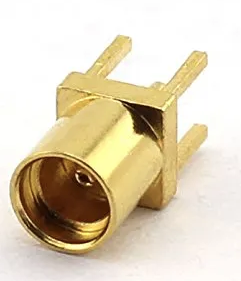
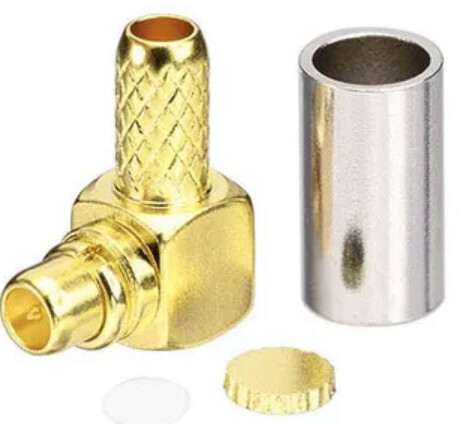
Shortening the cable is also on an U.FL cable possible. This could be done on the SMA side. But the MMCX is more reliable.
I know, there are many points against it. But also points which speaks for it (especially DIY)! For the BPI-R3 I would not mentioned it, becase of the limitet space. But now with the additional board the situation changed.
So maybe next time ![]() ?
?
Board Design:
I’m hoping Sinovoip stays at the concept of an external WiFi Board. And I mean not because of “we have to do it” there is no space on the main board! I thought I had read on the OpenWrt One/AP-24.XY - project, that the Wifi chips should be on the main board (like a roof should be on a car). As a reliability test guy, i know how bad it could be to have contact problems. As this guy I have to say → bigger main board and all components soldered together ![]() .
But as a maker i want to have a choice
.
But as a maker i want to have a choice ![]() !
!
I congratulate for staying at the same main board size like the other router boards ![]() .
.
What i whished that card would be:
Last days I read much about pure OS, lineageOS and the fairphone. Comparing the different strategies → to make the world better in different aspects.
But beeing relistic, could the next future WiFi cards be the new part of the Banana Pi business strategy: → reducing development costs because of component reusability for instance for R4 AND R4 mini.
→ I’m talking about a sandwitch design with space between the layers for cooling! I not only mean the “mini” → I also mean the big router models.
→ layers/cards for a fan, RJ45 expansion, wifi …
A major point on R3 mini, OpenWrt One/AP-24.XY and R4 are the amount of RJ45 connections. A additional board with 3 (mini) or 6 more RJ45 jacks would make a difference and could reused for the next router board generations…
It is just a suggestion!
The BPI-R3 mini was a huge step in case design. The end customer was the target? But what makes R3 mini so special? It’s just a rhetorical question (I like Mediatek combined with OpenWRT). Could more w-Lan antennas or an additional SFP cage change the game? I think so (esspacially for the SFP cage, because of Internet over fiber optics). The SFP was a breakthrough for BananaPI. If you get this in a little square box than you have something which is more special. And like the wifi board, it could be recycled in the next generation.
The compeditors in this area are :
Summary: → I’m a fan of MMCX antenna sockets and because of recycling I would like as much as possible single components witch are arranged one above the other.
April for a 6 antenna board? Close to pointless for me. Too little too late.
@howardthedm Welcome to the reality of design, manufacture, certification & business. There is no such thing as a magic wand.
@sinovoip,have you got driver correctly loaded? I get a timeout before the 3rd wifi interface should come up (2 i see in ip a). I guess we need firmware for the second frontend mt7977IA for this to solve.
Chinese new year… Answer may take some time …
I suppose you have to rename mt7996_eeprom_233.bin to mt7996_eeprom.bin to have the driver pick that up instead. In the end this should be done using dt-overlay again with distinct dtbo for each wifi module type (BE14 vs. BE19) needing user-supplied EEPROM data.
Are you sure _233 is for this wifi module/frontend and i only need to change eeprom file? There are more _233 files and it’s not clear that these are for this wifi board.
I’m just guessing, because those _233 files aren’t used anywhere by the driver and the BE14 module got 2T2R in 2.4 GHz, 3T3R in 5 GHz and 3T3R on 6 GHz, ie. 233 makes sense to be somehow.
thx, tried all 233 files for mt7996, but issue is similar, i see only the first 2 wifi devices (i expected 3 or is this wrong as the new board has only 2 frontends, so 2G4+5G should work over 1,but looking in iw list it seems 5G is missing), but i get no timeout messages
root@bpi-r4-v11:~# dmesg | grep mt7996
[ 14.674304] mt7996e_hif 0001:01:00.0: vgaarb: pci_notify
[ 14.679658] mt7996e_hif 0001:01:00.0: assign IRQ: got 119
[ 14.685090] mt7996e_hif 0001:01:00.0: enabling device (0000 -> 0002)
[ 14.691490] mt7996e_hif 0001:01:00.0: enabling bus mastering
[ 14.697195] mt7996e_hif 0001:01:00.0: vgaarb: pci_notify
[ 14.702687] mt7996e 0000:01:00.0: vgaarb: pci_notify
[ 14.707691] mt7996e 0000:01:00.0: assign IRQ: got 116
[ 14.714133] mt7996e 0000:01:00.0: enabling device (0000 -> 0002)
[ 14.721544] mt7996e 0000:01:00.0: enabling bus mastering
[ 14.866833] mt7996e 0000:01:00.0: HW/SW Version: 0x8a108a10, Build Time: 202a
[ 15.071021] mt7996e 0000:01:00.0: WM Firmware Version: ____000000, Build Tim5
[ 15.118893] mt7996e 0000:01:00.0: DSP Firmware Version: ____000000, Build Ti7
[ 15.160500] mt7996e 0000:01:00.0: WA Firmware Version: ____000000, Build Tim2
[ 15.543104] mt7996e 0000:01:00.0: eeprom load fail, use default bin
[ 15.550618] mt7996e 0000:01:00.0: registering led 'mt76-phy0'
[ 15.559589] mt7996e 0000:01:00.0: registering led 'mt76-phy1'
[ 15.567459] mt7996e 0000:01:00.0: vgaarb: pci_notify
root@bpi-r4-v11:~#
wonder about the Firmware version is blank ![]() seems not ready yet…and eeprom was not loaded, but it’s there
seems not ready yet…and eeprom was not loaded, but it’s there
root@bpi-r4-v11:~# ls /lib/firmware/mediatek/mt7996/
mt7996_dsp.bin mt7996_eeprom_tm.bin mt7996_wa.bin mt7996_wm_tm.bin
mt7996_eeprom.bin mt7996_rom_patch.bin mt7996_wm.bin
but const is labeled default…maybe the default bin is the file in lib/firmware…but see no status, that it was loaded successfully.
but i do not see the error “Invalid default bin”, so i guess it is loaded successfully
@dangowrt have you got your card?
Hi, I’m currently having trouble finding any options to buy this card.
The aliexpress shop linked above doesn’t have any and seems to be in a state of disarray (no products showing for me). Also the shop that is linked in the wiki is dead and references to the joom shop (I found this here: Elektronik, Marke: BPI – Preise mit Lieferung von Artikeln aus China im Joom Onlineshop) But neither carry the wifi module.
Is this available anywhere and if so where?
Would really like to have one or any other compatible wifi module for the R4.
The official Wifi NIC is not available for sale yet. Frank (and some others) only received one as a developer preview.
You will have to wait with us others, who are eagerly awaiting the public sale of the module.
It’s getting kind of silly waiting this long. Even if it doesn’t work there should be a way to buy that includes a disclaimer about it not working properly yet. I’d love to help figure the driver issue out. I throughly enjoy working on those types of issues, but can’t help because I can’t yet buy it. I bought my bpi-r4 in January thinking by now the NIC would be out. I’m starting to get worried that it won’t be released. The BPi-R4 is still fun to play with, but maybe I should have waited for the nic before I bought it. Hope we see it for sale soon.
